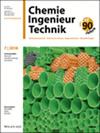氢氧化钠溶液中反应性二氧化硅材料的水热溶解
IF 1.5
4区 工程技术
Q3 ENGINEERING, CHEMICAL
引用次数: 0
摘要
反应性二氧化硅材料(如玻璃状二氧化硅或霞石)在 100 至 220 °C 的温度下溶解于 NaOH 碱液中长达 7 天。对液态和固态反应产物进行化学分析。得到的钠水玻璃的二氧化硅浓度高达 27 wt %,SiO2/Na2O 摩尔比高达 3.7。实验数据通过近似算法进行了评估。初始粒度减小率介于 0.1 至 7 µm h-1 之间,具体取决于温度和起始材料的选择。讨论了热力学和动力学之间的相关性。本文章由计算机程序翻译,如有差异,请以英文原文为准。

Hydrothermal Dissolution of Reactive Silica Materials in Sodium Hydroxide Lyes
Reactive silica materials like vitreous silica or cristobalite were dissolved at temperatures between 100 and 220 °C for up to 7 days in NaOH lyes. The liquid and solid reaction products were analyzed chemically. Sodium water glasses with silica concentrations of up to 27 wt % and molar SiO2/Na2O ratios of up to 3.7 were obtained. The experimental data were evaluated by an approximation algorithm. The initial size reduction rates ranged between 0.1 and 7 µm h−1, depending on the temperature and the choice of starting materials. Correlations between thermodynamics and kinetics were discussed.
求助全文
通过发布文献求助,成功后即可免费获取论文全文。
去求助
来源期刊

Chemie Ingenieur Technik
工程技术-工程:化工
CiteScore
3.40
自引率
15.80%
发文量
601
审稿时长
3-6 weeks
期刊介绍:
Die Chemie Ingenieur Technik ist die wohl angesehenste deutschsprachige Zeitschrift für Verfahrensingenieure, technische Chemiker, Apparatebauer und Biotechnologen. Als Fachorgan von DECHEMA, GDCh und VDI-GVC gilt sie als das unverzichtbare Forum für den Erfahrungsaustausch zwischen Forschern und Anwendern aus Industrie, Forschung und Entwicklung. Wissenschaftlicher Fortschritt und Praxisnähe: Eine Kombination, die es nur in der CIT gibt!
 求助内容:
求助内容: 应助结果提醒方式:
应助结果提醒方式:


